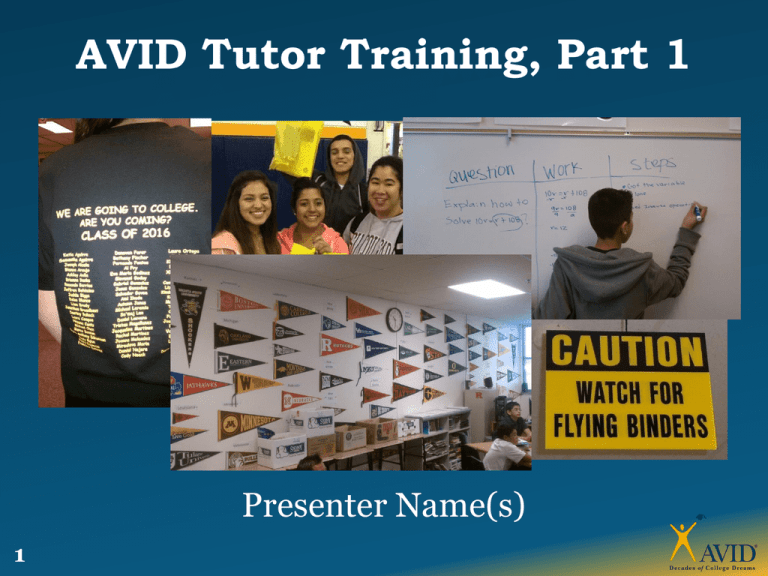
AVID Tutor Training, Part 1
Presenter Name(s)
1
Your Tutor Trainer
• [Note to Presenter: Add your introduction
and contact information here.]
2
Appointment Clock Partners
3
HO 1
Agenda: Tutor Training, Part 1
• AVID and Tutorials Overview
• Before the Tutorial
• During the Tutorial
• After the Tutorial
• WICOR and the Tutorial Process
• Practice Tutorials
Don’t forget the Parking Lot!
4
Norms
Ask questions.
Engage fully.
Integrate new information.
Open your mind to diverse views.
Utilize what you learn.
Used with permission of Learning Forward,
www.learningforward.org. All rights reserved.
5
5
Our Essential Question
CORNELL NOTES
TOPIC/OBJECTIVE:
HO 2-5
NAME:
CLASS/PERIOD:
DATE:
What do I need to know
to facilitate Socratic tutorial sessions
in an AVID Elective classroom?
ESSENTIAL QUESTION:
6
What Is AVID?
…A structured college preparatory
system working directly with schools and
districts
…A direct support structure for firstgeneration college-goers, grades 4-16
…A schoolwide approach to curriculum
and rigor
7
8
8
The AVID Elective Student Profile
Has academic potential:
9
Average to high test scores
2.0-3.5 GPA
College potential with support
Desire and determination
The AVID Elective Student Profile
Meets one or more of the following
criteria:
10
First to attend college
Historically underserved in four-year
colleges
Low income
Special circumstances
A Sample Week in the AVID Elective
Mondayor Tuesday
Thursday
Block
•Daily
A Sample
WeekWednesday
in the AVID
ElectiveFriday
Schedule
AVID
Curriculum
Tutorials
AVID
Curriculum
Combination for
Block Schedule
Curriculum:
Writing
College and Careers
Strategies for Success
Critical Reading
11
Tutorials
Combination for
Block schedule
Binder
Evaluation
Field Trips
Media Center
Speakers
Motivational
Activities
(within block)
Tutorials:
Collaborative Study Groups
Writing Groups
Socratic Seminars
WICOR: Writing
12
Writing process (prewrite to final draft)
Respond, revise
Edit, final draft
Cornell notes
Quickwrites
Learning logs, journals
WICOR: Inquiry
13
Skilled questioning
Socratic Seminars
Quickwrites/discussions
Critical thinking activities
Writing questions
Open-minded activities
WICOR: Collaboration
14
Group projects
Response/edit/revision groups
Collaboration activities
Tutorials
Study groups
Jigsaw activities
Read-arounds
WICOR: Organization
Tools
Binders
Calendars, planners, agendas
Graphic organizers
Methods
Focused note-taking system
Tutorials, study groups
Project planning, SMART goals
15
WICOR: Reading
16
SQ5R (Survey, Question, Read, Record, Recite,
Review, Reflect)
KWL (What I Know; What I Want to Learn;
What I Learned)
Reciprocal teaching
“Think-alouds”
Text structure
Critical reading
“Getting the GIST”
HO 6
• Read the AVID College Readiness System
notes that you just took.
• Work with a partner to create a “GIST” by
composing a 20-word sentence that
summarizes AVID.
• Share out sample summaries.
17
Jennifer’s Tutorial Video
18
HO 7-8
The Tutorial Process
Why do we do Socratic tutorials in
AVID?
To prepare AVID students for success in
their current classes, as well as building
the skills necessary to be ready for
college.
19
Binder Briefing
(Highly successful people are organized.)
20
HO 9-10
HO 11
The CORNELL WAY
The College-Readiness Skill
of Focused Note-Taking
21
Our Essential Question
CORNELL NOTES
TOPIC/OBJECTIVE:
NAME:
CLASS/PERIOD:
DATE:
How should tutors aid
students in the process of learning
how to take effective notes?
ESSENTIAL QUESTION:
22
Why Does Structured Note-Taking Matter?
23
Four Elements of Cornell Notes
Note-Taking
Creating the format of your notes
Organizing your notes
Note-Making
Reviewing and revising the content of the notes
Noting key chunks of material in the notes
Exchanging ideas and collaborating
about the material
24
Four Elements of Cornell Notes
Note-Interacting
Link all the learning together by writing a
summary
Learn from your notes by studying them
Note-Reflecting
Written feedback from a peer, tutor, or teacher
Address the feedback by focusing on one area of
challenge
Your reflection over an entire unit and how
your notes helped you learn and retain
information
25
How Tutors Should Support Cornell Notes
Note-Taking
• Make sure that all notes taken and used in
tutorials follow the Cornell note process.
• Help students learn note-taking
conventions.
26
How Tutors Should Support Cornell Notes
Note-Making
• Help students learn to “chunk” their notes
accurately and effectively.
• Support the writing and refining of higherlevel questions in the left column.
• If possible, attend a content-area class
with the students, take notes, and then
compare your notes to theirs.
27
How Tutors Should Support Cornell Notes
Note-Interacting
• Have students read the summary
from their notes out loud to the
group as the group provides
feedback.
• Constantly ask students, “Have you
been studying from your Cornell
notes?”
28
How Tutors Should Support Cornell Notes
Note-Reflecting
• Check for the quality and quantity of
Cornell notes during binder checks,
especially for students struggling in
specific classes.
• Ask students what aspect of Cornell notes
they’re working on this week from their
“Cornell Note Focused Goal Activity.”
29
CORNELL WAY
1. Find an elbow partner to compare notes.
2. “Chunk” your notes.
3. Write a question in the left column that
covers the material in the corresponding
“chunk.”
4. Share your questions with your elbow
partner.
5. Write a summary in the bottom section
that addresses the Essential Question and
each of the questions that they wrote.
30
“Matt’s Tutorial” Video
• In what ways did Matt utilize his binder in
preparation for AVID tutorials?
• In what ways did Matt utilize his Cornell
notes in preparation for AVID tutorials?
31
Tutorial Request Forms
HO 12-13
• Read and review “Step 2: Completing the
Tutorial Request Form (TRF) as
Homework.”
• In pairs, complete the reflection from
“Reflective Learning Log: Step 2: Pre-work
Is Key.”
32
HO 14
Before
the
Tutorial
33
HO 15
“Think-ALoud”
Coaching
Tool
34
Pg. 61
Debrief
• As a tutor, how do you think the TRF will
aid the AVID Tutorial Process?
• Which component of the TRF do you
anticipate being most challenging for
students?
35
Review Jennifer’s TRF
HO 16
• What do you notice about Jennifer’s prework?
• What is the difference in her initial
questions from her Point of Confusion
question?
• How does the reflection that Jennifer
wrote aid her learning?
36
Review Jennifer’s Notes
HO 16
• Who took notes for Jennifer? What do you
notice about the notes?
• What do you notice about the contentclass notes that Jennifer brought to the
tutorial?
37
Where is Inquiry in the Tutorial Process?
Step 1:
• In their academic classes, students take
Cornell notes on the material presented in
lectures, textbook readings, videos, handouts,
etc.
•
38
After class, students review their notes,
interact with their notes, create questions in
the column on the left, and write a summary
at the bottom of the notes.
HO 17
39
Costa’s
Levels of
Thinking
40
HO 18-22
Vocabulary
Concept
Map
41
Preparing for Tutorials
Room Arrangement:
•
Desks/chairs are in a half-circle
(horseshoe) next to the board.
Dividing into Groups:
•
42
Discuss how groups are formed.
HO 23-24
Debrief
• How does this part of the process impact
your role as a tutor?
43
HO 25-26
During
the
Tutorial
44
Beginning the Tutorial Session
Jason’s
Social
Studies
Tutorial
45
HO 27
Debrief
• Which step of the 30-Second Speech was
easiest for you as the tutor to coach?
• Which step was the most difficult to
coach?
• If an AVID student were to ask you the
purpose behind the 30-Second Speech,
how would you respond?
• Where might the 30-Second Speech be
applicable in a college setting?
46
30Second
Speech
Prompt:
“What have you
learned about
setting up for
and beginning a
tutorial?”
47
HO 28
HO 29
It’s All
About
the
Process!
48
Debrief
• How do you see the requirement of the
tutor having to take three-column notes
both helping and hindering your overall
performance as a tutor?
49
Checking for
Understanding
• What obstacles
can you foresee
with this step of
the AVID Tutorial
Process?
• Why is this step a
vital part of the
entire process?
50
HO 30-33
HO 34
Reflection
What learning
took place?
What is the
relevance?
51
Debrief
• Why is the reflection portion of the TRF
important?
• How will you emphasize and guide/coach
AVID students through this process?
52
WICOR-izing Tutorials
53
HO 35
The Tutorial Process
54
HO 36-39
HO 40
Tutor
Facilitation
Protocol
55
One-Pager Requirements
1. State the step number and when the step occurs
in the tutorial process (before, during, or after).
2. Identify the key components/main ideas of the
step.
3. Include a visual representation that represents
the step (must be different than the symbol
provided in the reading).
4. Contain a slogan that will serve as a memory
device for the step.
5. Identify which steps from the “Tutor Facilitation
Protocol” happen during your assigned step of
the tutorial process.
56
Tutorial Roles Jigsaw
57
HO 41-43
Tutorial Roles Jigsaw
Quickwrite Prompt:
If you had to choose one
word to sum up the role that
you have been assigned,
what would it be and why?
58
Fishbowl Tutorial
HO 44-46
Fishbowl Tutorial (six volunteers needed):
• Tutor
• Student Presenter
• Group Members
59
Fishbowl Tutorial
60
Observation and Feedback
61
HO 42-43
Fishbowl Tutorial Debriefing
Group Members: “How did the AVID
Tutorial Process go for you, and what did
it feel like to only use inquiry?”
Student Presenter: “How did the AVID
Tutorial Process work for you, and did you
feel that the inquiry and collaboration of
the group members helped you?
62
Fishbowl Tutorial Debriefing
Tutor: “How were you able to facilitate
questioning and interaction between the
student presenter and the group?”
Observers: “What did you notice in
regards to the involvement of group
members, the presenter, and the tutor
using the Tutorial Process Observation
Checklist?”
63
Summary vs. Reflection
64
Tutorials
Cornell
Notes
Reflections
Summaries
HO 47
Debrief
Tutorial Reflection Prompts:
• How would you best teach another student to find
the answer to your POC?
• What is a different way to solve your POC?
• What helped you to better understand your POC?
• How could you apply this learning to another
subject, topic, or concept that you are currently
studying?
• How would you apply what you learned today to
solve or better understand a real-world situation?
65
Repeating the Inquiry Process
66
HO 48-49
Let’s Collaborate! Mock Tutorial Session
• Gather in groups of six.
• Complete the pre-work for your assigned
problem.
• Begin the tutorial session.
67
If You Are Currently the…
HO 50-55
• Student Presenter: “Five Marks Problem”
• Tutor: “Circle Problem”
• Observer: “Amoeba Problem”
• Group Member #1: “Jamais/Toujours Problem”
• Group Member #2: “Rope Ladder Problem”
• Group Member #3: “Water Lily Problem”
68
Reflect and Connect
HO 56-61
1. Read and review “30-Second Reflect and
Connect Student Presenter Connection
Protocol.”
2. Model Jennifer’s tutorial group.
3. Write a reflection on the Tutorial Request
Form.
69
Debrief
• As a tutor, what will you be mindful of as you
build collaborative tutorials?
• What if the student does not complete the
pre-work?
• What if the students do not bring resources?
• What if the AVID teacher is not leading the
class very well?
• How can you make tutorials fun and
engaging?
70
Wrap-Up/Closing
Parking
Lot
Questions?
71
Thank You!
Please complete the Tutor Training,
Part 1 Evaluation Form and leave it
on your table.
Thank you for choosing to make a
difference for AVID students.
72
Contact Information
73

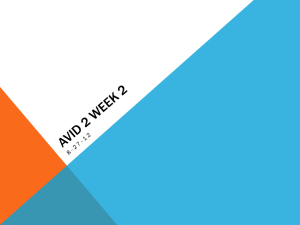
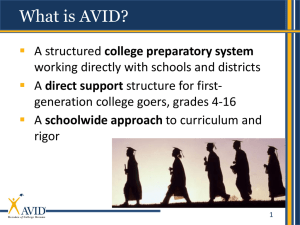
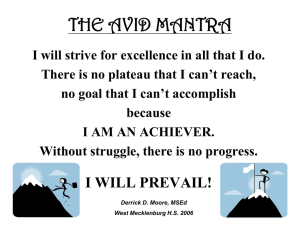
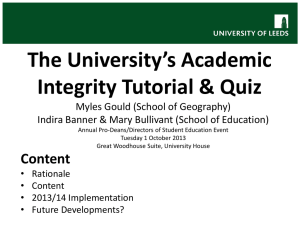

![avid parent night 1[1].](http://s2.studylib.net/store/data/005364026_1-3545164f7508a237d75956b3943e7277-300x300.png)